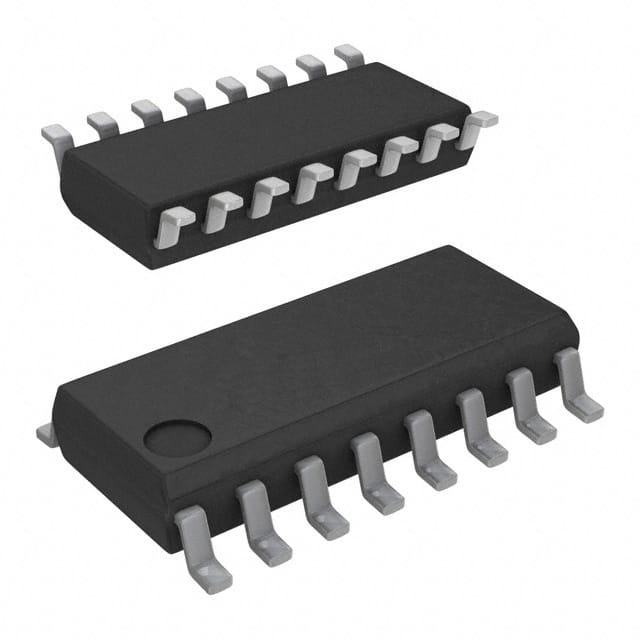SN74LV165ADRG3
Product Overview
Category: Integrated Circuit (IC)
Use: The SN74LV165ADRG3 is a 8-bit parallel-load shift register designed for use in various digital applications. It can be used to convert parallel data into serial data or vice versa.
Characteristics: - Low-voltage operation: 2 V to 5.5 V - High-speed data transfer: up to 100 MHz - 8-bit parallel input and output - Serial data input and output - Parallel load capability - Schmitt-trigger inputs for noise immunity - Wide operating temperature range: -40°C to 85°C
Package: The SN74LV165ADRG3 is available in a small-outline integrated circuit (SOIC) package. This package offers compactness and ease of integration into electronic circuits.
Essence: The essence of the SN74LV165ADRG3 lies in its ability to efficiently handle parallel-to-serial and serial-to-parallel data conversion tasks. It provides a reliable and versatile solution for digital systems requiring such functionality.
Packaging/Quantity: The SN74LV165ADRG3 is typically sold in reels containing 2500 units per reel.
Specifications
- Supply voltage range: 2 V to 5.5 V
- Input voltage range: 0 V to Vcc
- Output voltage range: 0 V to Vcc
- Operating temperature range: -40°C to 85°C
- Maximum clock frequency: 100 MHz
- Maximum power dissipation: 500 mW
- Input capacitance: 3 pF
- Output capacitance: 6 pF
- Input leakage current: ±1 µA
- Output current: ±8 mA
Detailed Pin Configuration
The SN74LV165ADRG3 has a total of 16 pins, each serving a specific function. The pin configuration is as follows:
- SER (Serial Data Input)
- QA (Parallel Output A)
- QB (Parallel Output B)
- QC (Parallel Output C)
- QD (Parallel Output D)
- QE (Parallel Output E)
- QF (Parallel Output F)
- QG (Parallel Output G)
- QH (Parallel Output H)
- GND (Ground)
- CLK (Clock Input)
- ~PL (Parallel Load Input)
- ~CE (Chip Enable Input)
- S0 (Shift/Load Control Input)
- S1 (Shift/Load Control Input)
- Vcc (Supply Voltage)
Functional Features
The SN74LV165ADRG3 offers the following functional features:
- Parallel-to-serial or serial-to-parallel data conversion
- Shift and load control inputs for flexible operation
- Schmitt-trigger inputs for improved noise immunity
- Wide operating voltage range for compatibility with various systems
- High-speed data transfer capability for efficient data handling
Advantages and Disadvantages
Advantages: - Low-voltage operation allows for compatibility with modern digital systems. - High-speed data transfer enables efficient data processing. - Schmitt-trigger inputs provide noise immunity, ensuring reliable operation. - Compact SOIC package facilitates integration into electronic circuits.
Disadvantages: - Limited to 8-bit parallel input/output, may not be suitable for applications requiring larger data widths. - Requires external clock and control signals for proper operation.
Working Principles
The SN74LV165ADRG3 operates based on the principles of shift registers. It can be configured to either shift data in or out, depending on the desired mode of operation. When shifting data in, the parallel data is loaded into the register and then shifted out serially. Conversely, when shifting data out, the serial input is shifted in and then made available in parallel at the output pins.
Detailed Application Field Plans
The SN74LV165ADRG3 finds applications in various digital systems where parallel-to-serial or serial-to-parallel data conversion is required. Some potential application fields include:
- Communication systems: Used for data serialization and deserialization in communication protocols such as UART (Universal Asynchronous Receiver-Transmitter).
- Data acquisition systems: Enables efficient conversion of parallel sensor data into a serial stream for processing or transmission.
- Display drivers: Facilitates the conversion of parallel pixel data into a serial format for driving display panels.
- Industrial automation: Used in control systems to handle parallel data from sensors or actuators in a serial manner.
- Test and measurement equipment: Allows for the conversion of parallel test signals into a serial format for analysis or storage.
Detailed and Complete Alternative Models
- SN74HC165: Similar 8-bit parallel-load shift register with higher voltage operation (2 V to 6 V) and faster clock frequency (up to 133 MHz
Senaraikan 10 soalan dan jawapan biasa yang berkaitan dengan aplikasi SN74LV165ADRG3 dalam penyelesaian teknikal
Sure! Here are 10 common questions and answers related to the application of SN74LV165ADRG3:
Q: What is SN74LV165ADRG3? A: SN74LV165ADRG3 is a 8-bit parallel-in/serial-out shift register IC, commonly used for data storage and transfer in digital circuits.
Q: What is the operating voltage range of SN74LV165ADRG3? A: The operating voltage range of SN74LV165ADRG3 is typically between 2V and 5.5V.
Q: How many inputs does SN74LV165ADRG3 have? A: SN74LV165ADRG3 has 8 parallel inputs (D0-D7) and 1 serial input (SER).
Q: Can SN74LV165ADRG3 be cascaded to increase the number of inputs? A: Yes, multiple SN74LV165ADRG3 ICs can be cascaded together to increase the number of inputs.
Q: What is the maximum clock frequency supported by SN74LV165ADRG3? A: SN74LV165ADRG3 can support clock frequencies up to 50 MHz.
Q: How does the serial output (QH') work in SN74LV165ADRG3? A: The serial output (QH') of SN74LV165ADRG3 provides the shifted data from the parallel inputs when the shift register is clocked.
Q: Can SN74LV165ADRG3 be used for both parallel-in and parallel-out operations? A: Yes, SN74LV165ADRG3 can be used for both parallel-in and parallel-out operations depending on the control signals applied.
Q: What is the typical power consumption of SN74LV165ADRG3? A: The typical power consumption of SN74LV165ADRG3 is around 4.5 mW.
Q: Does SN74LV165ADRG3 have any built-in debounce circuitry? A: No, SN74LV165ADRG3 does not have any built-in debounce circuitry. External debounce circuitry may be required for noisy inputs.
Q: What are some common applications of SN74LV165ADRG3? A: SN74LV165ADRG3 is commonly used in applications such as data acquisition systems, digital control panels, and parallel-to-serial data conversion.
Please note that the answers provided here are general and may vary depending on specific application requirements.


